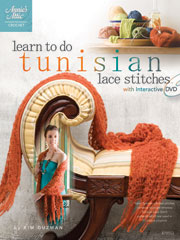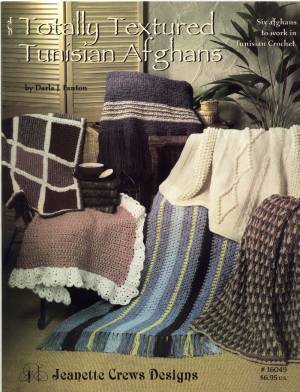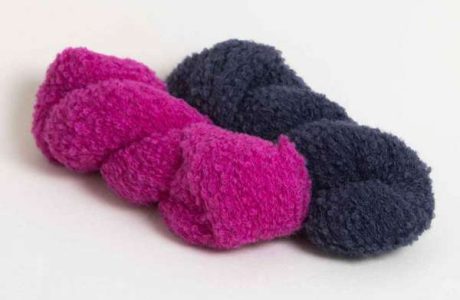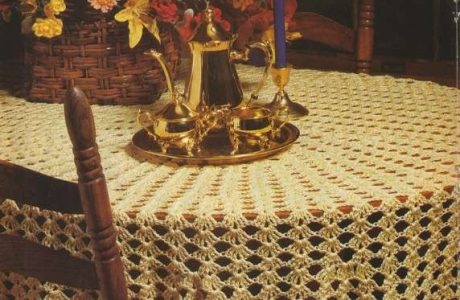A while back when I began having problems with carpal tunnel syndrome, I decided to give tunisian crochet a try. I’m a slow crocher, at best, and had always found tunisian to be extremely slow for me. Somehow, something changed. I’m now hooked on this method of knitting which is sometimes called by other names, including Afghan Stitch, Railroad Knitting, Shepherd Knitting, Crochetnit, MoEZ, CroHook, and maybe others. By any name, the technique is pretty much the same.
For some patterns, you’ll need a special tunisian hook – a hook that’s inline and typically longer than the traditional hook. Some hooks are double ended (crochetnit and afghan) and some are cabled. But, for a lot of tunisian patterns, especially scarves and panels for afghans, you can easily use a traditional hook. I’ve got all of the above and find the cabled hooks to be more trouble than they’re worth. But, they might be more useful to me if I wanted to make a full sized afghan. Storing all those stitches on a hook is simply impossible. More about that later.
So, what are the advantages/disadvantages of what I’ll just call tunisian crochet? One of the advantages is that it typically uses less yarn than regular crochet. Another advantage is that it’s a bit easier to make a charted afghan, IMO, with tunisian stitch than making a whole afghan in single crochet (ain’t happening!). The main advantage I discovered, as stated above, is that I find it a bit less stressing on my wrist. That advantage may well disappear if I chose to crochet a full sized afghan. The weight of the afghan might be difficult. However, if you’re one who wants to make a character afghan, a team afghan or sweater, or something with a fairly intricate charted picture, this stitch may well be perfect for you!
Disadvantages? Well, one might have to buy more hooks. (On second thought, to what crocheter would this be a DISadvantage??) There are fewer books in print that offer tunisian patterns. There are fewer websites offering tunisian patterns and thus fewer free patterns.
As usual for me, when I discover a new ‘skill’, technique, or addiction, I have to get more information – all that I can lay my hands on. I began with what I had on hand, the occasional chapter in crochet books describing tunisian with one or two patterns. Pretty quickly, I yearned for more. I found this book offered online and popped for it. It has turned out to be a great resource:
Wanting to learn how to do Tunisian Crochet? Check out this Online course “Tunisian Crochet For Beginners”.

ENCYCLOPEDIA OF TUNISIAN CROCHET BY ARNIE GRABOWSKI
Other authors also offer wonderful books of tunisian technique and patterns, notably Kim Guzman:

http://www.anniesattic.com/crochet/detail.html?prod_id=78100
AND Darla Fanton:

http://www.cutecrochet.com/darla/darla.html
So far, I’ve made five panels in a dusty pink and off white for a baby afghan that I need to whip stitch together and I’ve crocheted several scarves. Right now, I’m working on a scarf in a pretty Yarn Bee bright variegated wool blend yarn in tunisian double crochet. I like having that spiral bound Encyclopeida of Tunisian Crochet in my lap or on the sofa next to me to refer to until I memorize a stitch pattern. This one is really easy, with the yarn doing most of the design ‘work’ for me. I’m using a wooden P hook (double ended) that I bought years ago and never used. Now, although I don’t need a double ended hook for this project, it’s the perfect hook size for this project. That’s one nice thing about these hooks, you can still use them for ‘regular’ crochet. I could actually use a regular hook for this project as it’s only 16 stitches across, but I don’t have a wooden one in this size. I have found that I prefer wooden hooks for tunisian – and I do not prefer them for regular crochet. Surprised myself with that.
At any rate, I hope you’ll give tunisian a try. It’s relaxing and creates a totally different looking fabric than ‘regular’ crochet. It might just be what you need for inspiration or to use up some yarn that didn’t work in any other project. Go for it!





entralac crochet is a variation of tunsian crochet only on a small scale; I am making my daughter a gray and black afghan -one row gray diamonds, one row black. Goes very slow on the black row.
Does anyone know where to or a have a pattern for a sweater done in tunsian stitch or afghan knit stitch
I don’t know where the idea that Tunisian crochet uses less yarn comes from. It generally produces a thicker fabric which requires more yarn! There are many reasons to take it up but yarn saving isn’t one of them.
you might try a web site i discovered…My Life in Knots..concerning entralac crochet
Your post is a couple of years old so by now, you’ve probably found other resources. I really like Kim Guzman’s patterns but wouldn’t recommend the Encyclopedia by Angela Grabowski. It was my first book on Tunisian crochet and I was amazed that she didn’t even show how to cast off! A lot of poor quality black and white photos that, in the end, all looked pretty much the same. Hope you don’t mind that I disagreed with your review. I’m off to look at the rest of your delightful blog! CC